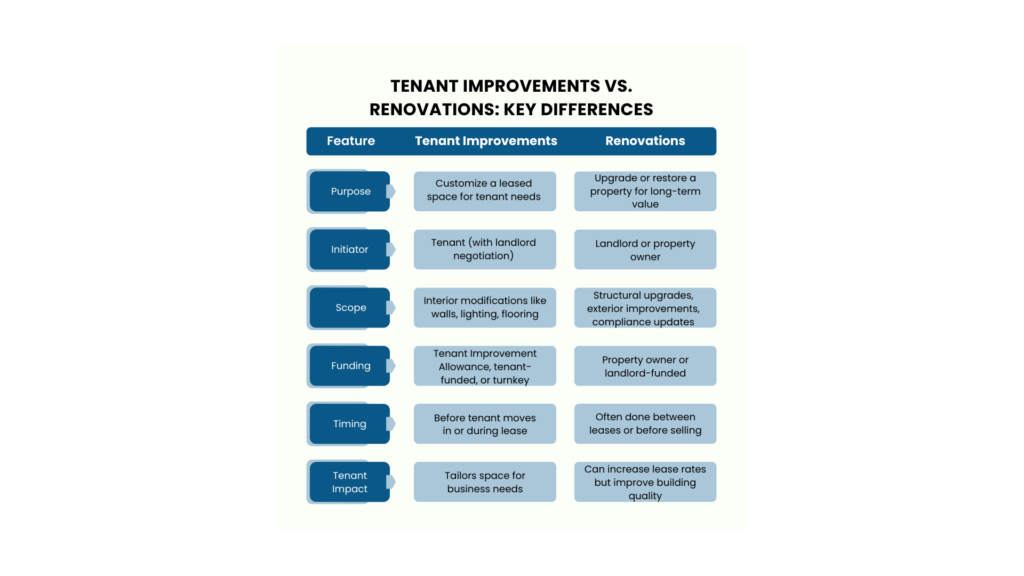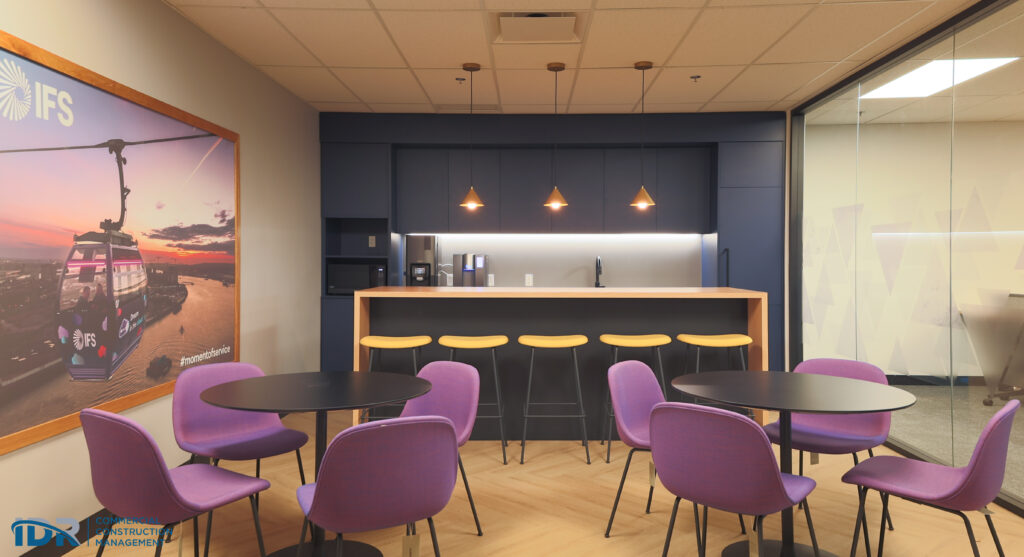When updating a commercial property, we often interchange two standard terms: tenant improvements and renovations. While both involve modifying a space, they have different purposes and distinct processes. If you’re a business owner, property manager, or landlord in Vancouver, understanding the difference between tenant improvements and renovations can help you make informed decisions that align with your goals, budget, and lease agreements.
In this article, we break down tenant improvements vs. renovations, explore the benefits of each, and explain how they apply to commercial construction projects in Vancouver’s competitive real estate market.
What Are Tenant Improvements?
Tenant improvements (TIs) refer to custom modifications to a leased commercial space to meet the tenant’s specific needs. These changes are often negotiated between the tenant and landlord as part of the lease agreement, with costs either covered by the landlord (through a tenant improvement allowance) or the tenant.
We often refer to office layout modifications as tenant improvements, such as adding or removing walls to create private offices or open workspaces, depending on business needs. Office TI may also include upgrading flooring, lighting, and HVAC systems to enhance comfort and functionality and installing or adjusting electrical and plumbing fixtures to support specific business operations, such as restaurant kitchens or specialized retail setups. Sometimes, tenants use TI to incorporate branding elements such as custom signage, finishes, or unique design features to align the space with their company’s identity. Accessibility adjustments are also a common tenant improvement, ensuring the space meets regulatory requirements and employee and customer accommodation.
Who Pays for Tenant Improvements?
In Vancouver, tenant improvements are typically funded in one of three ways. (1) A Tenant Improvement Allowance (TIA), where the landlord provides a budget for improvements. Tenants and landlords often negotiate this as part of the lease agreement. (2) A Turnkey Build-Out is when the landlord manages and funds all improvements before the tenant moves in, ensuring the space is ready. (3) Tenant-funded improvements allow tenants to cover costs independently, often giving them more control over design and customization.
RELATED READ: Commercial Tenant Improvement Planning: What to Know Before You Sign an Office Lease in Vancouver
What Are Renovations?
Renovations refer to broader construction work that improves or restores a building or unit. Unlike tenant improvements, the property owner often initiates renovations to increase property value, improve energy efficiency, or modernize aging infrastructure.
Renovations can involve structural upgrades, such as reinforcing walls, replacing outdated plumbing, or upgrading electrical systems to meet modern standards. Full-scale remodelling of retail or office spaces attracts new tenants or adapts to changing market demands. Exterior renovations, including facade improvements, roofing, and landscaping, help enhance curb appeal and increase property value. Many property owners also invest in energy-efficient retrofits, such as upgrading insulation, installing solar panels, or implementing smart building systems to reduce long-term operational costs. Compliance upgrades, including seismic retrofitting and accessibility improvements, are often required to meet local regulations and ensure the safety of occupants.
Who Pays for Renovations?
The property owner or landlord typically funds renovations since they enhance the long-term value of the building. In Vancouver, where commercial property values continue to rise, investing in renovations can significantly boost rental income and tenant retention.
Understanding these differences is crucial for landlords and business owners in Vancouver, where the real estate landscape is fast-paced and evolving.

How Tenant Improvements and Renovations Impact Vancouver’s Commercial Market
For Business Owners & Tenants
If you own a commercial building in Vancouver, strategic renovations can increase your property’s value and attract long-term tenants willing to pay premium lease rates. Given Vancouver’s environmental and safety standards, energy-efficient upgrades and seismic retrofits are particularly beneficial.
For Property Owners & Landlords
If you own a commercial building in Vancouver, strategic renovations can increase your property’s value and attract long-term tenants willing to pay premium lease rates. Energy-efficient upgrades and seismic retrofits are particularly beneficial given Vancouver’s environmental and safety standards.

Which One Do You Need?
Deciding between tenant improvements vs. renovations depends on your role and goals. As a tenant, you’ll want improvements aligning the space with your business needs. If you’re a landlord or property owner, investing in renovations can enhance the long-term value of your building and attract premium tenants.
Understanding these differences in Vancouver’s commercial real estate market can help you make better investment and leasing decisions. Whether you need tenant improvements to customize your office or a full-scale renovation to modernize your property, having the right construction team is key to ensuring a smooth process and high-quality results. Reach out to IDR today to discuss your construction needs.
RELATED READ: Navigating Commercial Tenant Improvement Costs in Greater Vancouver: IDR Budgeting Guide

